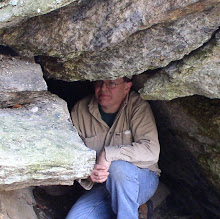An afternoon was spent scrounging the central Berkshire countryside for signs of marble; finding dolomitic, calcitic, and contacts with the local schists. Even a couple quasi-cave formations presented themselves. But the next day, it was time to return to the conglomerates: my somewhat dormant projects within the Connecticut River Valley.
More ledges were examined for long lost formations photographed by John Lovell from Amherst over 140 years ago. No success to be found here. But I returned to a well known site that Lovell also covered at one point. Here a premiere cave formation exists that has long been know to history - for almost two hundred years! I recreated a number of Lovell's views, shot a few of my own modern interpretations, before moving on to another set of ledges.
In returning to Graves Ledge - or Rock Shelter - I came with a much more 'improved' image of Etta's Nook courtesy of a recent internet auction. Although I must have visited Etta's more than a dozen times in the past, I finally got to see exactly where JL had taken his photo from. A modern 'now' photograph is pretty much obscured with tree growth. But before leaving the Valley again, I was able to visit the ledge above Etta's and see it's geologic connection with Graves' Cave. The Cave is formed by gravity assisted movement of a large section of the cliff that is adjacent to Etta's, and forming the Nook's left wall.





